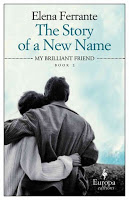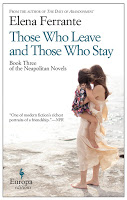When I was a child, almost every book I read was about a girl and her friends. It seemed a self-evident truth, that as young girls, our most interesting and engaging relationships were not with family or burgeoning romantic interests, but with our friends.
From them we would draw our strength and find our solace. My friends and I would engage in heated discussions over which Babysitter’s Club member we were (Kristy), or whether we were a Nancy, George, or Bess (Nancy). Even after our tastes had diverged enough that we were no longer interested or capable of arguing around the same series, it was the books that featured strong female friendships that drew me in and most affected me.
 Until I picked up Elena Ferrante’s My Brilliant Friend, the first in the Neapolitan series, it hadn’t occurred to me how much these novels, so large a feature of my adolescence, had been almost entirely missing from my adulthood. Lately, I’ve been thinking a lot about my childhood best friend, and naturally I began seeing the two of us reflected in Ferrante’s pages. While neither I nor my friend are very much like Elena or Lila in either character or circumstance, there is a healthy dose of the universal in Ferrante’s depiction of female friendship. They grow closer and apart at almost random intervals; they mimic and mirror each other; they compete for imagined ideals.
Until I picked up Elena Ferrante’s My Brilliant Friend, the first in the Neapolitan series, it hadn’t occurred to me how much these novels, so large a feature of my adolescence, had been almost entirely missing from my adulthood. Lately, I’ve been thinking a lot about my childhood best friend, and naturally I began seeing the two of us reflected in Ferrante’s pages. While neither I nor my friend are very much like Elena or Lila in either character or circumstance, there is a healthy dose of the universal in Ferrante’s depiction of female friendship. They grow closer and apart at almost random intervals; they mimic and mirror each other; they compete for imagined ideals.
 Told from Elena’s perspective, My Brilliant Friend captures all the tricky, complicated, and even unpleasant nuances of her feelings towards Lila. It is a love borne of envy and challenge but also of deep respect and admiration. Lila, shown only through Elena’s eyes, is naturally kept more of a mystery, though she is written to draw perhaps more intrigue and sympathy from readers than Elena herself. We may wonder how the story would look from Lila’s perspective, but it also feels quite natural for the Lilas of the world to have books written about them and that the Elenas of the world should do the writing. When we meet the pair, as children in post-war Italy, they initially seem very similar, and it is within the crannies of their divergences that Ferrante quietly interrogates love, loyalty, class, tradition, and destiny. At the book’s close, I was left pondering the question I didn’t know the title was asking: which girl is the Brilliant Friend?
Told from Elena’s perspective, My Brilliant Friend captures all the tricky, complicated, and even unpleasant nuances of her feelings towards Lila. It is a love borne of envy and challenge but also of deep respect and admiration. Lila, shown only through Elena’s eyes, is naturally kept more of a mystery, though she is written to draw perhaps more intrigue and sympathy from readers than Elena herself. We may wonder how the story would look from Lila’s perspective, but it also feels quite natural for the Lilas of the world to have books written about them and that the Elenas of the world should do the writing. When we meet the pair, as children in post-war Italy, they initially seem very similar, and it is within the crannies of their divergences that Ferrante quietly interrogates love, loyalty, class, tradition, and destiny. At the book’s close, I was left pondering the question I didn’t know the title was asking: which girl is the Brilliant Friend?
 My Brilliant Friend is a relaxing read, but slow, comfortable and intimately thoughtful, like the waning hours of a very good slumber party. The plot, for what it is, is completely wrapped up in the characters of Elena and Lila; while the atmosphere of mid-century Italy provides interesting and detailed background color, Ferrante deals in depth rather than breadth. To fully enjoy the book, we must believe that Lila and Elena are worth getting to know thoroughly and gradually, just as they are getting to know themselves. The first book of what is now a four-part series, My Brilliant Friend covers the childhood and adolescence of Lila and Elena. Books 2 and 3, Story of a New Name and Those Who Leave and Those Who Stay, follow the girls into adulthood and middle age. The fourth book, The Story of the Lost Child, which Ferrante says will be the last of the Neapolitan books, will be released in English on September 1 of this year.
My Brilliant Friend is a relaxing read, but slow, comfortable and intimately thoughtful, like the waning hours of a very good slumber party. The plot, for what it is, is completely wrapped up in the characters of Elena and Lila; while the atmosphere of mid-century Italy provides interesting and detailed background color, Ferrante deals in depth rather than breadth. To fully enjoy the book, we must believe that Lila and Elena are worth getting to know thoroughly and gradually, just as they are getting to know themselves. The first book of what is now a four-part series, My Brilliant Friend covers the childhood and adolescence of Lila and Elena. Books 2 and 3, Story of a New Name and Those Who Leave and Those Who Stay, follow the girls into adulthood and middle age. The fourth book, The Story of the Lost Child, which Ferrante says will be the last of the Neapolitan books, will be released in English on September 1 of this year.
 If you’re looking for more books about female friendship geared towards adult readers, try Summer Sisters by Judy Blume. Both books chronicle lifelong friendships of two women, starting from childhood; however, Blume’s s American setting might provide a more familiar backdrop to readers than Ferrante’s Italy.
If you’re looking for more books about female friendship geared towards adult readers, try Summer Sisters by Judy Blume. Both books chronicle lifelong friendships of two women, starting from childhood; however, Blume’s s American setting might provide a more familiar backdrop to readers than Ferrante’s Italy.

